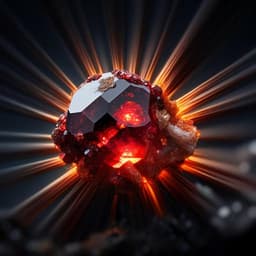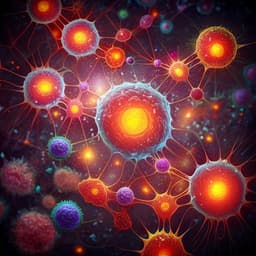
Engineering and Technology
Ultra high damage threshold optics for high power lasers
Y. Michine and H. Yoneda
Discover groundbreaking advancements in high-damage-threshold optics achieved by Yurina Michine and Hitoki Yoneda, utilizing neutral gas as an active medium to control powerful laser beams efficiently with compact components.
~3 min • Beginner • English
Introduction
High-energy laser systems have achieved dramatic gains in pulse energy over decades, but optical damage thresholds of solid-state components (mirrors, gratings) have not kept pace, necessitating meter-scale optics. Typical nanosecond damage thresholds are 1–200 J/cm² for dielectric mirrors and 0.1–12 J/cm² for structured optics, limiting usable fluence, especially at high repetition rates due to probabilistic damage and irreversibility. Plasma-based transient optics have been explored, but rely on free-electron polarizability and require substantial energy deposition, leading to short lifetimes and high drive power. The authors propose a transient diffraction optic based on neutral gas with linear absorption, leveraging ozone–oxygen mixtures to create large, periodic density modulations that yield strong refractive index gratings while maintaining very high damage thresholds (>1 kJ/cm² for ns pulses). The research question is whether such a neutral-gas transient grating can deliver high diffraction efficiency and significantly higher damage threshold than conventional optics for high-power laser handling.
Literature Review
The paper situates the work within: (1) scaling of laser energies to multi-megajoule levels; (2) limitations of solid optics damage thresholds (dielectric mirrors and gratings) for ns pulses; (3) prior transient plasma optics—plasma gratings and plasma mirrors—which provide index modulation via free electrons but require high energy deposition and suffer short lifetimes; (4) earlier concepts for gas-phase optics (e.g., gas-lens telescopes) and volume-phase gratings; (5) ozone absorption spectroscopy underpinning UV-driven processes; (6) laser-induced breakdown in gases and aerosol effects on thresholds. This background motivates a neutral-gas approach that minimizes energy deposition per active atom, targets near-100% density modulation, and exploits volume grating behavior for high-efficiency, asymmetric diffraction.
Methodology
Medium and concept: Use a mixed gas of ozone (O₃) and oxygen (O₂) at 1 atm as the active medium. A spatially periodic deep-UV 'writing' beam at 248 nm (KrF excimer, 10–15 ns) is created with a Michelson interferometer to form high-visibility fringes. O₃ strongly absorbs at 248 nm; absorption dissociates O₃ to O + O₂, followed by rapid recombination at atmospheric pressure. The absorbed photon energy becomes heat in the gas, establishing a spatially periodic temperature profile that drives coupled acoustic and entropy waves, evolving into a large-amplitude periodic density modulation (grating) with near-100% modulation depth after ~50–60 ns.
Gas flow system: Pure O₂ (99.5%) is ozone-processed via atmospheric dielectric barrier discharge (13 MHz RF, ~10 kV/mm) with precooled O₂ (~10°C). The ozone-mixed gas flows laminarily through a rectangular tube (cross-section ~4–10 mm along propagation × 10 mm height). At ~15 cm downstream, an open window region (two opposing 6 × 10 mm apertures) allows laser access without windows. Flow is pumped at the downstream end to maintain constant ozone density at the window. Typical flow ~5 L/min in a 10 × 10 mm cross-section; ozone fraction 1–10% tuned for performance. Spatial ozone density uniformity across the open window is verified with a 287 nm probe via absorption; variations are kept within a few percent.
Optical setup and timing: The 248 nm excimer is operated narrowband with injection seeding (2–3 cm⁻¹) to ensure high fringe contrast. The UV intensity profile is image-relayed with a spatial filter for uniform illumination; absorption is saturated to achieve nearly uniform energy deposition along the beam path. The period of the grating is set by the interferometer geometry; writing pulse duration is kept shorter than grating period/sound speed to ensure efficient initial energy deposition.
Probing and diffraction measurement: Ozone density temporal evolution is measured with a 5 ns, 287 nm probe (absorption); refractive index modulation is measured with a 5 ns, 598 nm probe. The diffraction performance is characterized using a 532 nm, 6 ns, ~1 mJ Q-switched Nd:YAG probe beam (single spatial mode, multi-longitudinal-mode; Δλ/λ ~10⁻⁴). The density-modulated volume in typical measurements is ~6 mm × 10 mm × 10 mm. Diffraction efficiency is defined as 1st-order diffracted energy divided by incident pulse energy. Synchronization between writing and probing pulses is within a few nanoseconds; the optimal delay corresponds to peak density modulation (~tens of ns), with a ~10 ns temporal window for maximal efficiency.
Optimization and volume grating operation: Conditions (ozone density, UV writing fluence, medium thickness, grating period, probe wavelength and incident angle, and timing) are optimized to realize a volume-phase grating that funnels energy predominantly into the +1 order while suppressing 0 and −1 orders. Saturable absorption ensures uniformity along depth; the optical path modulation reaches ~1 µm at peak density modulation.
Angle tolerance and bandwidth: Angle-dependent efficiency is measured for ~40 µm grating period; 80% efficiency tolerance ~0.06°. Calculations assuming step-like density modulation and integrated phase along tilted rays agree with measurements. Simulations indicate a spectral bandwidth for high efficiency of ~1.5% (compatible with ~100 fs pulses).
Wavefront quality: Wavefronts of 0th and 1st order beams are measured via self-referenced interferometry with a single-mode-fiber output for high spatial mode quality; Zernike polynomial analysis quantifies aberrations. First-order diffracted beam exhibits <λ/10 RMS wavefront distortion under nominal conditions. Additional tests introduce a co-timed, co-propagating focused 532 nm, 6 ns test beam (25–150 mJ focused to 100 µm; 0.4–2 kJ/cm²) to evaluate wavefront integrity near and above breakdown thresholds.
Damage threshold testing: Breakdown is diagnosed by visible emission, transmitted beam profile changes, and wavefront distortion. Tests compare air, ozone-mixed O₂ without UV, and ozone-mixed O₂ with saturated UV writing. Using 6 ns, 532 nm pulses, the breakdown threshold of the ozone-mixed gas grating medium is determined.
Nonlinear effects assessment: For ns operation in oxygen-rich gas (n−1≈10⁻⁵), nonlinear refractive effects (e.g., r-SRS, SBS) have thresholds well above operating conditions; they are negligible. For fs pulses, self-phase modulation is the lowest-threshold effect; measured threshold energy density ~6 J/cm² at 800 nm, suggesting still favorable margins relative to many solid optics, especially if using higher-threshold noble gases.
Key Findings
- Transient neutral-gas diffraction grating realized in ozone–oxygen mixture with UV-written periodic heating yields near-100% density modulation within ~50–60 ns and an optical path variation ~1 µm.
- High diffraction efficiency: Average 1st-order efficiency 96% at a UV writing fluence of 63 mJ/cm² (248 nm, ~10–15 ns). Single-shot standard deviation of efficiency: 4.2%. Optimal temporal window for peak efficiency: ~10 ns.
- Wavefront quality: First-order diffracted beam exhibits <λ/10 wavefront distortion under high-efficiency conditions; negligible additional distortion below damage threshold when co-propagating with an intense test beam.
- Damage threshold: Breakdown threshold of the ozone-mixed gas grating medium is 1.6 kJ/cm² for 6 ns, 532 nm pulses. This exceeds conventional solid optics thresholds by over two orders of magnitude. Corresponding peak intensity ~2.7×10¹¹ W/cm².
- Angular and spectral acceptance: 80% efficiency angular tolerance ~0.06° for ~40 µm period grating; simulated usable spectral bandwidth ~1.5% (compatible with ~100 fs pulses).
- Aperture and scaling: Demonstrated density-modulated volume ~6 × 10 × 10 mm³ (aperture ~60 mm²). Extrapolation from 6×10 mm² aperture and ~40 mJ KrF drive (linear regime) suggests capability to control up to ~1 kJ pulse energies with ~1 cm-scale optics driven by <50 mJ UV.
- Uniformity: Saturated ozone absorption yields uniform energy deposition through depth; 2D efficiency maps show near-100% efficiency at beam center, with edge roll-off attributed to limited UV temporal coherence (improvable with better seeding).
- Nonlinear optics: For ns pulses, r-SRS/SBS thresholds are well above operating conditions; negligible impact. For fs pulses, SPM threshold ~6 J/cm² at 800 nm; using noble gases could further improve thresholds.
Discussion
The study demonstrates that a neutral-gas-based transient diffraction element can achieve both high efficiency (≈96%) and a very high damage threshold (1.6 kJ/cm² for 6 ns at 532 nm), addressing the core limitation of conventional solid-state optics in high-energy laser systems. By converting UV absorption in ozone into spatially periodic heating and leveraging subsequent hydrodynamics to produce large density modulations, the device operates as a volume-phase grating, concentrating energy into the +1 order with low wavefront aberration. The results validate that the neutral-gas approach can maintain optical quality while withstanding fluences more than two orders of magnitude higher than typical solid gratings, enabling a significant reduction in the required optic size for handling high-energy beams. For ultrashort pulses (ps–fs), while nonlinear effects in gases reduce the effective threshold compared to ns operation, they are still expected to exceed those of solid optics, especially with alternative gases. The demonstrated angular tolerance and bandwidth indicate practicality for various laser parameters. Overall, this approach offers a pathway to replace multiple solid optical components (e.g., switches, filters) with transient, self-healing gas-phase elements, mitigating cumulative damage and downtime in high-power laser facilities.
Conclusion
This work introduces and validates a transient, neutral-gas diffraction grating formed in an ozone–oxygen mixture via UV-written periodic heating, achieving 96% 1st-order diffraction efficiency, a 1.6 kJ/cm² damage threshold for 6 ns pulses, <λ/10 wavefront distortion, and practical angular/spectral acceptances. The device operates with modest UV drive fluence (63 mJ/cm²) and demonstrated ~60 mm² aperture, with extrapolation indicating feasibility to control ~1 kJ beams using ~1 cm optics driven by <50 mJ UV pulses. These results suggest a route to substantially downsized, damage-resilient optics in high-energy laser systems. Future work could focus on scaling aperture while maintaining laminar flow and uniform ozone density, improving UV temporal coherence to enhance edge efficiency uniformity, exploring noble gases to further increase damage thresholds and manage ultrashort-pulse nonlinearities, and integrating such gratings into system-level optical switching and beam-shaping architectures.
Limitations
- Pulse-duration dependence: For picosecond/femtosecond pulses, gas nonlinearities (e.g., self-phase modulation) reduce the effective damage threshold compared to nanosecond operation, though still potentially superior to solids.
- Aperture scaling: The primary limitation to increasing optic size is maintaining laminar flow and uniform ozone density in a windowless section; cross-flow uniformity and turbulence control are critical.
- Temporal window: Peak diffraction efficiency occurs within ~10 ns around the optimal delay; timing jitter and pulse structure of the probing laser (multi-mode spikes) can affect efficiency and stability.
- Coherence constraints: Edge reductions in efficiency arise from limited temporal coherence of the UV writing beams; improved seeding/coherence is needed for uniform large-area performance.
- Environmental sensitivity: Presence of aerosols or particulates in the gas can lower breakdown thresholds; careful gas purity and flow control are required.
- Above-threshold operation: Wavefront distortions become severe above the breakdown threshold, constraining safe operational margins.
- Shot-to-shot fluctuation: Measured single-shot efficiency fluctuation of ~4.2% under test conditions may require stabilization for precision applications.
Related Publications
Explore these studies to deepen your understanding of the subject.







